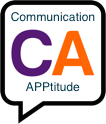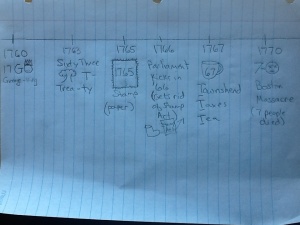Sunday, December 23, 2012
Happy Holidays
Warmly,
Deena & Beth
Tuesday, December 18, 2012
Memory Strategy for Timelines
 Beth Lawrence, MS, CCC-SLP[/caption]
Beth Lawrence, MS, CCC-SLP[/caption]Hi. I wanted to share a short post showing how important it is to anchor all information that will be needed for a test (and hopefully for long-term recall!) The images are pretty small, but if you click on them, they pop up larger.
This student was required to recall not only the events leading up to the Revolutionary War, but also the dates. He tried to simply "memorize" them, but he kept choosing the wrong dates for each event. We created a visual timeline and, because he has benefited from using rhyme in the past, we created rhymes to connect the dates and the events when we could.
In the second section, I used another strategy--ANYthing to get the information to stick! The student had to recall two facts about 1775, and we couldn't think of very much for this one, so I broke down what he had to remember into syllables, making it fit so that the first one had seven syllables (i.e., The-Bat-tle-of-Lex-ing-ton = 7) and the second had five syllables (i.e., Bat-tle-of-Con-cord = 5) for 1775. We would love to hear from you teachers, tutors and parents, about strategies you are using!
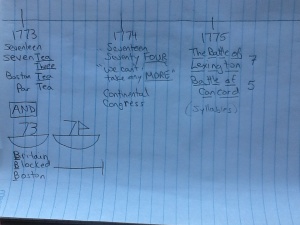
Monday, December 17, 2012
Language Games to Improve Sentences Skills
 Deena Seifert
Deena SeifertM.S., CCC-SLP[/caption]
If you are looking to add some games to your family or work collection, there are quite a few games in the stores now to improve sentence structure. Improving a student's sentence structure is not just important for conversational skills, but it's the building block of written language.
Before a child can write simple, compound and complex sentences, they must first be able to use them aloud. We do a lot of practice with our students in oral syntax (grammar). We practice making complete sentences aloud with and without pictures for cues. Just practicing this skill can be veryhum drum, so I try toincorporate a game or two into our speech-language sessions to make working on this skill more fun. Here are just a few of my favorite sentence games...

[caption id="attachment_329" align="alignleft" width="150"]
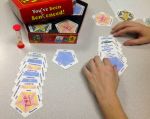 You've Been Sentenced[/caption]
You've Been Sentenced[/caption]You've Been Sentenced is a fun game of pentagonal-shaped cards. Each side of every card has a word and the points that word is worth. Players try to make the longest, most grammatically correct sentence they can and score points in the process. This has been a big hit with middle school and high school students. You can play the game as is or add on additional decks. It has add ons for players interested in pop culture, science fiction/fantasy, word challenges, sports highlights and gourmet.
[caption id="attachment_327" align="alignright" width="150"]
 Mad Libs Criss Cross[/caption]
Mad Libs Criss Cross[/caption]MadLibs Criss Cross Board Game is a fun inexpensive way to work on sentences. Cards come in 3 categories: nouns, verbs and miscellaneous. Players work on creating the longest possible sentence, each card worth points for the player. You can write in some of your own words on blank cards. Players enjoy the wacky sentences they create themselves.
[caption id="attachment_328" align="alignleft" width="150"]
 Rory's Story Cubes Actions[/caption]
Rory's Story Cubes Actions[/caption]If you are familiar with Rory's Story Cubes did you know they make an actions deck? Sometimes students get a blank look on their face when asked to create a sentence or a story. When this happens I pull out the story cubes and watch it inspire a student to create a story. The small visual pictures on the dice trigger names, objects and events to help a student create a sentence or story.
Hope this helps with your holiday shopping or inspires you to look at games in a different way. What's your favorite speech-language game or activity? Let us know!
Wednesday, December 12, 2012
Writing Checklists for Students
 Deena Seifert,
Deena Seifert,M.S., CCC-SLP[/caption]
My child is consistently getting lower marks on writing assignments, because he forgets to add a title or other detail.
Sometimes I wish I could sit on my students' shoulders in class or at home when they are writing their papers and remind them to indent, to edit their work or to remember to include a title.
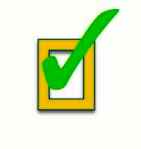 Recently, I decided to print out a checklist for one of my students whom I'll call, "Ben." I printed out multiple copies, slipped them in a polyurethane sleeve, labeled the sleeve with the class name and had the student add a set to each class binder that requires writing.
Recently, I decided to print out a checklist for one of my students whom I'll call, "Ben." I printed out multiple copies, slipped them in a polyurethane sleeve, labeled the sleeve with the class name and had the student add a set to each class binder that requires writing.I just got an email from Ben's mother saying,
Ben revised his writing assignment tonight and did such a great job. I am so proud of him. Having the checklist in his head helped as he wrote. I sat with him, asked questions, and watched him type his own thoughts. At the end he went thru the checklist again and realized he had done everything. It was such a pleasant experience. No fretting, just cheering.
Here's the checklist Ben's mother is referring to:
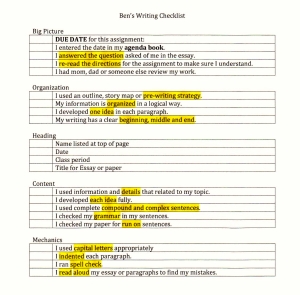
Something that was so easy to create, made a big difference in Ben and his mom's evening.
Tuesday, December 11, 2012
Working Memory Strategy
 Beth Lawrence, MS, CCC-SLP[/caption]
Beth Lawrence, MS, CCC-SLP[/caption]A couple of weeks ago, we had a post on how to help students with working memory deficits. The first step is to engage the student in dialogue about how the brain works, educating them about the processes required to perform simple short-term memory tasks versus tasks requiring active engagement while "holding onto" information. In the last year or so, I have begun using a technique that may seem a little strange, but I have seen some good results! In fact, just last week, one of my students was performing a complex language processing task that relies heavily on active listening and working memory: note-taking from an orally-presented paragraph. My student said, "OH! I just have to write down the MANCALA WORDS!" That will make no sense unless I back up and tell you the technique I had introduced to him about 4 months ago, and upon which we have been building his active listening/working memory skills.
For years I have been teaching students traditional techniques, such as visualizing, chunking and self-repetition of key words. About a year ago, one of my students simply could not grasp these concepts, and he could not identify which words in the speech stream carried more "weight" than others. I knew that I had to add a kinesthetic (i.e., hands-on experience using manipulatives) component. I did not want to write the words, because I wanted him to learn the principal of how to "highlight" words in the auditory speech stream--I did not want to give him a crutch for remembering the words, as that would not help him to improve his own memory skills. I happened to have my Mancala game with me, which contains 48 small stones and a board with 12 scoops carved into it. I wanted this student to recall directions so he could successfully complete a pencil-paper task. I placed one stone in each of the scoops on the top row of the Mancala board to represent each word in my utterance. He was to select only the stones from the top that carried strong meaning, placing them in the scoops on the lower half of the board. As he added a new stone to the bottom row, he was to chunk it and add it to the previous words. So my direction, "Write the letter A in the square," became, "Write," "Write letter," "Write letter in," "Write letter in square," as he selected each stone. He left the stones for the words, "the" in the holes on the top row. When we listen, words are not uttered and "dumped," words further down the speech stream are actively added to the previous words until one has the concept in mind.
To further enhance this experience, I teach a few basic signs for prepositions as movement helps cement location words. I have the student listen for prepositions, quickly making the sign to lock that location word in. Here is a video of a recent session with a student who held onto a two-step direction using this technique. Obviously we will need to work on increasing the speed with which she processes the language, but at this stage, she needs to rely on the kinesthetic process. [wpvideo 9Qo3ha9R][wpvideo pdCvD1Om][wpvideo RP32kmTc][wpvideo tTsiqKqV]
Thursday, November 29, 2012
Holiday Card Games for Language
 To continue our Holiday List for family games that are fun and target language skills, too, my students have a few favorites in the card game category.
To continue our Holiday List for family games that are fun and target language skills, too, my students have a few favorites in the card game category.[caption id="attachment_283" align="alignright" width="135"]
 HedBandz[/caption]
HedBandz[/caption]Putting your thinking cap on can take on a literal meaning when you play HedBandz. (Thanks to Stephanie for this idea.) It's a favorite of elementary school kids and looking silly playing the game can create lasting memories. Each player wears a headband with a card in it. More importantly players have to ask yes or no questions and remember the answers. I talk about categories with students and how a category is the road map for where you are going with a word's definition. Discovering your mystery word's category helps you find the meaning faster.
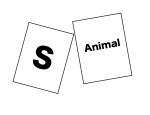
ASAP is another card game that helps with word-finding. You can make your own ASAP game if the mood strikes you. One player holds a deck of 26 categories and the other player has a deck of 26 letters. Each player lays a card for their deck on the table at the same time and whoever can name a word from the category that starts with the letter sound keeps the letter card. Whoever has the most cards at the end of the game wins.
[caption id="attachment_281" align="alignright" width="64"]
 In A Pickle[/caption]
In A Pickle[/caption]If you are one to "size up" the competition, In a Pickle is the a game for you. It's a card game for 2-6 players that involves placing cards whose object is larger or smaller than the target card. Players have to consider if a museum is larger than a library or if a giraffe is larger than an elephant. While placing cards by order of size, players have to consider multiple meanings of words and how words relate to each other - a great vocabulary skill game. I like to tell stories about the cards we are playing to work on narrative skills, as well.
[caption id="attachment_284" align="alignleft" width="150"]
 Spot It![/caption]
Spot It![/caption]If you are too hip to be square, then try Spot It (thanks to Karen for the idea) which is a round card game for all ages working on word retrieval, perceptual skills and cognition. Players are looking for one common feature between cards and when they Spot It, they call it out (word retrieval). It's a favorite of tutors and therapists. It gives kids success and encourages word retrieval for object names. The high schoolers enjoy it just as much as the elementary students.
[caption id="attachment_282" align="alignright" width="150"]
 Apples to Apples Jr.[/caption]
Apples to Apples Jr.[/caption]Finally, Apples to Apples has a game for any age. Younger players can play the junior version while older students prefer the regular version. It's a game of comparison and analogies and while I'm sold on the language value of the game, kids, teens and adults just think it's great fun.
Laughter is good for any age and these games are sure to bring out the giggles. In the next Language Games post, we'll talk about games to improve sentence skills.
Holiday Games for Word Retrieval
 As I make out my gift-giving lists for family and friends, I am reminded that there's no better time to think about buying family games. Did you know there are many games on the market that not only create quality family time, but also work on language skills.
As I make out my gift-giving lists for family and friends, I am reminded that there's no better time to think about buying family games. Did you know there are many games on the market that not only create quality family time, but also work on language skills.One of the areas I enjoy working on with my students is word retrieval, also referred to as word recall.
is the ability to recall specific words on demand in a timely manner.
We all have some form of word recall difficulties. Have you ever walked upstairs or to another part of your house and forgotten what you were there to get? You try to remember the first sound (phonemic cueing) of the item you were retrieving. Maybe you tried to picture it in your head (visualizing) or recalled what you were doing when you realized you needed this item. You could have tried to think of what the item goes with (association) or the category of the object (categorization).
When children are diagnosed with word retrieval difficulties it is much more debilitating. It creates difficulties when talking with their friends. They are more hesitant to enter into classroom discussions. Writing is almost always affected, because if they can't recall the words they need to use in their paragraph they will choose a less-specific word or write as little as possible.
Here are just some of the many games I like to use to increase word retrieval and have fun at the same time:
Outburst or Outburst Jr.
Players: 2 players or 2 teams or players
Ages: 7 years and older
This games has two-sided cards with a topic at the top of the card and a list of 10 items associated with the category or item at the top. Players try to name as many  items on demand in the given time.
items on demand in the given time.
Last Word
Players: 2 - 8, team play also
Ages: 8 years and older
Players names items in categories in a given amount of time and the player to provide the last word before the buzzer sounds gets to move a space ahead on the board.
Scattegories Categories
Players: 2 or more
Ages: 8 and older
Players name items in one category by letter or sound. I give players credit no matter what answer they give. If the word matches the letter, they get 2 points. If they name a word, but it doesn't start with the target sound, they get 1 point.
Showing your kids they can be successful in word retrieval and have fun at the same time is a priceless gift.
More games to come....
Wednesday, November 21, 2012
More Curricular Vocabulary
 Beth Lawrence, MS, CCC-SLP[/caption]
Beth Lawrence, MS, CCC-SLP[/caption]We've had some nice feedback on the curricular vocabulary post from a couple weeks ago. I wanted to share another example from working with a student last week. He was studying about Mesopotamia and had some linguistically complex definitions. This student has an excellent ability to memorize long strings of words, so he's been pretty successful on tests. These students are often devastated when the format of tests changes and they must explain their answers, or recognize a definition that is worded differently.
He was asked to learn this definition for city-state:
A self-governing city that controlled surrounding lands and villages
I knew the class had done a nice job of learning the concept in a multisensory manner, so my job was to help him link the idea to the language used to represent that idea. I had my student help me segment the definition like this:
a self-governing / city / that controlled / surrounding / lands and villages
Using Post-It notes, I started by writing the key word city on a Post-It, and spent time linking city with land and villages. I had him help me generate visuals for "land" and "villages." Here is a video of us using Kinesthetics to model the concept of "surrounding land and villages."
[wpvideo P3gMyAqb][wpvideo wcwn4qY4]
(It became clear that the student had not grasped the idea of "surrounding" so that is a concept I will anchor in my next session--surrounding used as an active verb versus an adjective to describe objects that happens to be in a particular location)
Back to this session...I then addressed the idea of control. In order to personalize it, we discussed and acted out who controls his house, his school, our country etc. I wanted to focus on "rules" and "money" as these concepts are most applicable to the control that a city had over a city-state. I wrote the word controlled on a Post-It note, drawing arrows outward toward the land and villages and placed it on the word city.
We were then ready to tackle self-governing. I wrote city and ruler on several Post-Its and spread them around on the table explaining that these rulers and cities did not get to tell our city what to do. Our city got to rule, or govern, themselves.
To expand his linguistic flexibility, we moved the components of the definition around:
Lands and villages were controlled by a city that governed itself
A city that was self-governed controlled the lands and villages that surrounded it
A self-governed city controlled the lands and villages that were around it
And finally, his teacher's chosen definition:

Monday, November 19, 2012
Written Language - Improving Sentence Structure
 Deena Seifert, MS, CCC-SLP[/caption]
Deena Seifert, MS, CCC-SLP[/caption]In our last post on written language, we talked about finding a great writing program to use as a guideline. No program is perfect for every situation and not all students learn the same way. So, it's important to draw from as many sources as you can and find what works not only for each student but for your teaching style.
Many of the students we work with fall back on writing only simple sentences because it's less frustrating and easier to do. I've learned that it's necessary to prompt students to write in complex sentences using a couple of strategies.
The first strategy involves practicing creating sentences aloud. We work on orally
 creating compound and complex sentences, focusing on how different conjunctions impact the sentence. We practice rearranging words to create two different sentences.
creating compound and complex sentences, focusing on how different conjunctions impact the sentence. We practice rearranging words to create two different sentences. After writing simple sentences to describe pictures, together with the student, we expand these sentences to include adjectives and adverbs. We gradually move from simple sentences to compound sentences to complex sentences.
It's good to have a list of conjunctions sitting next to the student while he writes. Providing a concrete list of the words that can be used to create compound and complex sentences is key. Ask the student to use one of the words in each of his sentences and be specific about which list you would like him to use. When they edit their work, if there are any simple sentences, have him combine or expand the sentences using a conjunction.

Different Kinds of Conjunctions. To keep it simple I'm only referencing the list of conjunctions above, but there are more conjunctions that can be added to the list. Coordinating Conjunctions combine two nouns/verbs, two phrases or two sentences together. For example:
- Two words: Mom and dad are on their way home.
- Two phrases: The elephant seemed calm, but charged at the trainer.
- Two sentences: The kids were told to sit in the bleachers or we would leave the game.
Subordinating Conjunctions connect phrases to answer the questions "why" and "when." Using the word "after," I can connect these two sentences:
- the football game is over (phrase)
- We will get some hot chocolate. (sentence)
- Result: After the football game is over, we will get some hot chocolate.
- Result: We will get some hot chocolate after the football game is over.
We teach that after could be placed at the beginning of the sentence or in the middle, but that the 2nd event must be mentioned right after the word after no matter where we write it.
Finally, Correlative Conjunctions are used in pairs and join two items that have a relation:
- Both the team and the coach were happy with the referee's call.
- Neither my brother or my sister were happy that I won.
- I will either have pie or cake after dinner is over.
 Practice, practice and more practice. It takes time and practice for a student to make this change. Writing simple sentences is all a student has been able to use or wanted to use, so it's like changing a habit - and we all know how hard that is to do. Patience, encouragement and a dash of creativity will help your child or your student move into this higher level grammatical skill.
Practice, practice and more practice. It takes time and practice for a student to make this change. Writing simple sentences is all a student has been able to use or wanted to use, so it's like changing a habit - and we all know how hard that is to do. Patience, encouragement and a dash of creativity will help your child or your student move into this higher level grammatical skill.
Tuesday, November 13, 2012
Working Memory & Metacognitive Skills
 Beth Lawrence, MS, CCC-SLP[/caption]
Beth Lawrence, MS, CCC-SLP[/caption]A significant component of working memory treatment is what is called, metacognitive training. Students (with learning difficulties) do not naturally bring to the learning process a sense of self-awareness, reflection, and task analysis that fosters an appreciation of what is needed to be successful within different academic contexts. (Wong, 1994; Wong, Wong, & Bienkinsop, 1989). According to Alvo, 1990, "Metacognition is the process of planning, assessing and monitoring one's own thinking; the pinnacle of mental functioning." In other words, being able to understand our brains and the processes that are required to accomplish varying tasks, as well as understanding what strategies should be employed for a variety of tasks.
"Metacognition is the process of planning, assessing and monitoring one's own thinking; the pinnacle of mental functioning."
 Most of us perform a variety of tasks without ever being aware of what our brains are doing to successfully accomplish the tasks. Using the example from last week, if we have to repeat, "3-7-9-4," most of us have no trouble repeating the sequence. Then, if we are asked to rank order the numbers from least to greatest, we might take a few seconds, look up, perhaps, then say, "3-4-7-9." There is actually quite a bit going on inside our minds as we attempt this later task, but we simply code-switch and do it naturally.
Most of us perform a variety of tasks without ever being aware of what our brains are doing to successfully accomplish the tasks. Using the example from last week, if we have to repeat, "3-7-9-4," most of us have no trouble repeating the sequence. Then, if we are asked to rank order the numbers from least to greatest, we might take a few seconds, look up, perhaps, then say, "3-4-7-9." There is actually quite a bit going on inside our minds as we attempt this later task, but we simply code-switch and do it naturally.If this type of code-switching does not happen automatically, the results can have an enormous impact on one's ability to listen to lectures, comprehend what is read, follow longer directions, take notes, write complex sentences and organized paragraphs to name a few. Many of our students approach these types of tasks in the same way they approach a short-term memory task, which is impossible to do successfully. Generally speaking, our brains can only hold between 5 and 9 bits of information in short-term memory. Unless one actively engages with the information, dumping the unnecessary bits, actively analyzing and storing the important bits in working memory, the cogwheels get "clogged".

We have to approach these types of tasks using a different set of strategies. But because our students do not do this automatically, they often do not realize there are a whole set of strategies to employ. In our next blog, we are excited to share some of these strategies with you!
References:
- Bruyer R, Scailquin JC (1998) The visuospatial sketchpad for mental images: testing the multicomponent model of working memory. Acta Psychol (Amst). 1998 Mar;98(1):17-36.
- Cheyne, J. A., Tarulli, D. (1999). Dialogue, difference, and the “third voice” in the zone pf proximal development. Theory and Psychology,9, 5-28. Web site: http://watarts.uwaterloo.ca/~acheyne/ZPD.http
- Hacker, D. J. (2001). Metacognition: Definitions and empirical foundations. The University of Memphis. Retrieved 11/12/12. Web site: http://www.psyc.memphis.edu/trg/meta.htm
- Metacognition. Retrieved 11/12/12. Web site: http://tip.psychology.org/meta.html
- http://www.nldline.com/bonnie_singer_and_tony_bashir.htm
Monday, November 12, 2012
Written Language - Finding a Program that Works
 Deena Seifert, MS, CCC-SLP[/caption]
Deena Seifert, MS, CCC-SLP[/caption]In graduate school (more than a few years ago), written language was not addressed in my courses. When I began in a group private practice, guess what my first student needed? You guessed it - help with written language.
My student was an athletic 8th grader who had just been identified as dyslexic. He had managed to go unidentified because he had fairly good memory skills. He finally hit a brick wall and couldn't rely on memorizing any longer. In our first session I asked him to write a paragraph for me so I could get a sample of his work. This big athletic guy started to tear up. He was anxious and frustrated with even putting one sentence on paper. As a matter of fact, the first 3 sessions I put a box of tissues on our work table and he used them. A year later the same student was writing beautiful research papers and felt such an accomplishment. How did we do it? (I say "we" because you really have to partner with your student in the writing process.)
Very quickly I began reading everything I could find on written language and looking for a program I could adapt to my practice. I happened upon a great writing program called Teaching Competence in Written Language by Dana Phelps-Terasaki & Trisha Phelps-Gunn. It's a systematic writing program that takes the student through 4 phases: developing ideas, independently writing and expanding sentences, paragraph writing by purpose, and theme writing. When I begin working with a new student, I evaluate their writing skills so I know where we need to begin in the program. I've modified how I use the program, adding my own writing lessons and drawing from other sources through the years. However, it's a great program and a good starting point if you are looking for a writing program.
[caption id="attachment_102" align="aligncenter" width="155"]
 Teaching Competence in Written Language by Dana Phelps-Teraski & Trish Phelps-Gunn[/caption]
Teaching Competence in Written Language by Dana Phelps-Teraski & Trish Phelps-Gunn[/caption]This program comes with a workbook, but I've adapted the lessons for computer. I've added my own lessons, as well, for when students need further practice in certain areas, such as complex sentence writing. For students who have keyboarding skills, I've put all my lessons on computer and iPad. Why not write on paper, you ask? Middle school and high school students are writing the majority of their papers on computer and even turning papers in online to their teachers. The laptop or computer gives the student more freedom in rearranging sentences. Using the word processor's editing skills to fix spelling, find synonyms, and use the thesaurus is a helpful lesson on new strategies for struggling writers. In addition, it's less frustrating to edit your paper on computer rather than having someone mark up your handwritten paper. Finally, and maybe more importantly, it helps boost a child's self-esteem to produce written work they've edited themselves and looks professional.
Even though we've come along way since I was in graduate school, parents, speech-language pathologists and teachers are constantly evaluating their students' needs and searching for ways to inspire them to improve their writing skills. In the next written language blog, I will talk about ways to improve a students' sentence structure.
Friday, November 9, 2012
Why Might It Be Difficult to Listen to Directions and Take Notes?
 Beth Lawrence, MS, CCC-SLP[/caption]
Beth Lawrence, MS, CCC-SLP[/caption]When our students have a difficult time with reading comprehension, following directions, listening in class, and/or engaging in conversation, we assess a wide variety of skills, one of which is called Working Memory. There is a difference between short-term memory, long-term memory and working memory. An example of a short-term memory task would be to quickly repeat, for example, 3-7-9-4. Long-term memory is when information is deemed important and is stored (hopefully in an organized manner) for long-term use to be recalled at a later time. Working memory is that memory which requires us to actively engage with the information. Rather than simply "spitting out" 3-7-9-4, we ask our brains to "do something" with what we just heard. For example, repeat the numbers in reverse, or say them in order from least to greatest.

When working memory is an area of weakness, it can impact such a wide variety of tasks! Listening to a story or a lecture in class requires solid working memory skills. One must be able to take in new information, assess whether it is pertinent to prior information, determine the relationship, and store the information in an organized manner, possibly using note-taking skills. All of this while listening to new information! During the writing process, many of our students will begin writing a sentence, and, due to weak working memory, forget where they were headed prior to finishing the sentence. Deena and I look forward to sharing some strategies that we use to help students who have difficulty with working memory.
Thursday, November 8, 2012
Technology Solutions for Struggling Readers
"My child doesn't like to read. Is there technology out there to help my child when they have to read for school?"
[caption id="attachment_64" align="alignleft" width="113"]
 Deena Seifert, MS, CCC-SLP[/caption]
Deena Seifert, MS, CCC-SLP[/caption]I hear this question more times than I can count in my private practice. Some students prefer to read rather than listen to audiobooks. Some like to be read to while they follow along in their book. Still others are auditory learners and prefer only to hear the passages. The first step is to determine which of these scenarios applies to your student or child.
Audiobooks
You have several options if the student prefers to hear with or without following along in the book. Bookshare.org is an initiative from Benetech, a non-profit company, that feels people with print disabilities "deserve to enjoy reading as much as other readers." This on-line library of digital books allows people with print disabilities to access copyrighted materials. Many publishers donate their print material to this great organization, as well. This service is free for U.S. students with a print disability. You can apply for a school or an individual membership and have a qualified professional (educational consultant, psychologist, speech-language pathologist) sign off on the application. It works with a computer or a tablet. Read2Go is the Apple app and Go Read! is the android app. The Text-to-Speech feature is well done. Finally, the Overdrive app allows you to "borrow" books from your local library for free. A great way to read e-books without the extra cost.
Book Readers
[caption id="attachment_80" align="alignleft" width="117"]
 Kindle Paperwhite[/caption]
Kindle Paperwhite[/caption]There are many book readers on the market: Kindle, Nook, and iPad to name a few. The only dedicated reader with Text-to-Speech is the Kindle (with the exception of the new Kindle Paperwhite which does not have Text-to-Speech). You can choose a male or female voice, slow, medium or fast rate.
While these are great tools, if a student is having trouble understanding what is being read please consult a speech-language pathologist that uses strategies like Lindamood Bell's Visualizing & Verbalizing Program to help him/her make movies in his/her head to recall details, and make inferences and predictions.
Monday, November 5, 2012
When to Seek Help for Speech Sound Errors
 Deena Seifert, MS, CCC-SLP[/caption]
Deena Seifert, MS, CCC-SLP[/caption]"People say they can't understand my child." We hear this a lot in our speech-language practices. Parents want to know when they should seek help for their child's speech. Our answer is, "It depends."
Usually by the age of three a child has their p, b, m, t, d and n sounds, but other sounds take longer to master. By the middle of kindergarten, a child should have all of his/her speech sounds. Some sounds take longer to come in. The r, s, l, and th sounds usually are the last to be corrected. If your child is not understood by strangers at the age of three 75% of the time, its' a good idea to consult with a speech-language pathologist.
Common errors are substituting a /w/ for the /r/ sound, such as "won" for the word "run" or "broder" for "brother." Sometimes children omit or leave out sounds such as "how" for "house." Other times they distort sounds in words so that the word doesn't sound quite right, like "pusgetti" for spaghetti.
My child's speech sounds so cute!
It sounds cute to parents when their children are preschoolers, but by the time they enter kindergarten their speech sounds should be closer to adult speech. I remember when my children no longer sounded like toddlers; I was sad, but it's necessary for our children's speech to grow with them.
If teachers, family and friends are noticing a problem with your child's speech errors and your child is mid-year in kindergarten or older, it's time to seek advice from a professional. A speech-language pathologist can evaluate your child and determine what kind of errors are being made, whether or not they are age-appropriate, and if you should seek treatment.
How do I find a speech-language pathologist?
You can contact the American-Speech-Language-Hearing Association (ASHA) at www.asha.org and locate a certified speech-language pathologist (SLP) near you or contact your child's school for a speech evaluation.
Why Seek Help?
Articulation disorders (speech sound disorders) can impact a child's spelling and reading skills. An articulation disorder can also impact a child's social life, because unfortunately peers can be less than kind to a child who "sounds funny." Whatever the motivation, it's wise to address this earlier rather than later. Early intervention is the key, because the prognosis for remediation is better for children who get help earlier.
Saturday, October 27, 2012
Suggestions for Curricular Vocabulary Challenges
 Beth Lawrence, MS, CCC-SLP[/caption]Deena shared some great techniques last week regarding vocabulary cards, which works for lots of students. I would like to share with you how we help our students with curricular vocabulary that have linguistically complex definitions. I have offered workshops in the Baltimore area for tutors and parents who want to help their students more effectively "anchor" curricular definitions. We're so excited to have this opportunity to share on a broader basis!
Beth Lawrence, MS, CCC-SLP[/caption]Deena shared some great techniques last week regarding vocabulary cards, which works for lots of students. I would like to share with you how we help our students with curricular vocabulary that have linguistically complex definitions. I have offered workshops in the Baltimore area for tutors and parents who want to help their students more effectively "anchor" curricular definitions. We're so excited to have this opportunity to share on a broader basis! So many of our middle school clients approach studying in this manner: pull out the index cards, “memorize” the definitions on the back, play a matching game or two with the index cards, then feel they are ready to take the big test. If the teacher “re-frames” the definition on the test, students with learning-disabilities often do not see that the "test" definition is equivalent to the one they memorized, it reads like a foreign language. We see this over and over in our practices. Big effort expended, little dividend to show for it. The frustration mounts…
Students with language-based learning disabilities often have difficulty with the grammar of the language, and/or with linguistic flexibility. Students tend to focus in on “fragments” of definitions, often missing the overarching meaning (Scott and Nagy 1997) Or, they master the “gestalt” of the concept but fail to recognize the components of the definition if they are not presented in the exact terms they had committed to memory. During our speech-language sessions, it is not our job to ensure the student is “ready” for the test, but we use the student’s scholastic materials to teach vital strategies so that they can overcome this. We will walk you through one of our techniques using a recent example.
A 5th grade boy (we will call him John) came to me with a dozen or so geography terms he had to memorize. I will use “Climate” to show the process I used with him. He had been asked to memorize the definition, "A pattern of weather in a particular location over a specified amount of time".
First, we discussed his background knowledge of the concept of climate. Like many students with whom Deena and I work, he was a bright boy who had absorbed the concept during class after discussions, watching film and engaging in class activities. Under the word CLIMATE, the teacher had asked the students to draw a quick picture of something that would trigger the idea of climate. He had drawn a sun. (Aside: I have seen this improvement in recent years--teachers are really getting the idea that visuals can help anchor information!) I take a slightly different approach, however. Because it is often difficult to draw one “quickie” picture that is meant to capture all aspects of the definition, I prefer to focus our artistic attention to the phrases within the definition, and address the word in a different way.
Secondly, on the flip side of the index card, I divided the definition into segments that represent concepts, like this:
[caption id="attachment_50" align="aligncenter" width="225"]
 Segment the Definition Into Phrases[/caption]
Segment the Definition Into Phrases[/caption]The Third step is to add a visual representation of each phrase that was bracketed, like this:
[caption id="attachment_49" align="aligncenter" width="225"]
 Climate Definition First Two Segments[/caption]
Climate Definition First Two Segments[/caption]This process went something like this. While I was drawing the shapes, I asked John to stop me when I had actually made a “pattern”. He stopped me the second I completed my last square. He understood the concept of “pattern”. John transferred the picture concept to his index card under the phrase “A pattern” and I asked him, “But are we talking about a pattern of shapes?” “No, a pattern of weather!” “OK, so we should draw something similar, but use weather pictures instead of shapes.” He drew a raincloud, sun and snow, repeated and knew he was done.
I repeated the process for "in a particular location"
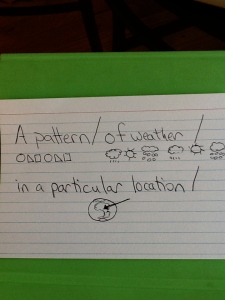
This shows the completed card:
[caption id="attachment_52" align="aligncenter" width="225"]
 Completed Curricular Vocabulary Card[/caption]
Completed Curricular Vocabulary Card[/caption]As I was drawing the "timeline" to represent the final concept, I asked him to direct me, and tell me when I was finished/how many years were passing. The term "specified" means someone is in charge of stating how long that time period is (weather experts). I wanted him to understand that, so I stopped the timeline when he told me to.
Once the index card was complete, the "language portion" of the program began. The next step was to ensure that John understood that the picture concept that we had drawn for each component could be explained using a variety of language:
“pattern of weather” could be:
weather that repeats
repeating weather
cycle of weather
prevailing weather conditions (slightly different meaning, but could be substituted on a test)
“in a particular location” could be:
in a specific place
in a specific location
in a place
in a region
in an area
somewhere
John needed to see that the definition for Climate could be:
“Over a long period of time, when weather repeats in a region”
or
“When there is a prevailing weather condition in a certain place on the globe”
Teaching linguistic flexibility is a necessity for our students. We have experienced great success with our students using this technique! If I ask my students (and their parents) nicely, I am sure we could upload several other examples of these curricular cards if the interest is out there!
Hope that helps,
Beth
Helping Struggling Writers
Good writing is clear thinking made visible. - Bill Wheeler
[caption id="attachment_64" align="alignleft" width="113"]
 Deena Seifert, MS, CCC-SLP[/caption]
Deena Seifert, MS, CCC-SLP[/caption]Middle School and high school students are writing 2-5 papers a week. It's a lot of pressure for the average student, so how do you help the struggling writer? One way is to help them get organized.
You can use low tech writing aids using paper and pen, fill-in-the-blank organizers or note cards. What about inspiring your child with an APP? Inspiration Software is a favorite of mine and my students. It's available in Windows, Mac and iPad formats.
Brainstorming
The first step in writing is brainstorming or rapidly writing your thoughts about the subject as they enter your mind. If you don't have an app, a low tech way is to have your student say aloud all the things they think about the subject they want to write about while you or your student/child records the thoughts on a clean sheet of paper. For a high tech solution, Inspiration has a feature called Rapid Fire where you can type in all your ideas about a subject. This can be done easily in the diagram format.
Visual Organization
Many struggling writers are strong visual learners, so being able to organize your thoughts in colors, shapes, and special fonts is not only appealing, but necessary to organize details, categories, ideas. A low tech method is to highlight, color-code and/or link the ideas. You can also put the information on index cards. Going high tech? Inspiration and another app called Popplet, can help you achieve this with a tough of a button or tap on the screen.
[caption id="attachment_46" align="aligncenter" width="300"]
 Example of Inspiration diagram[/caption]
Example of Inspiration diagram[/caption]Outlining
The next step is to organize the information by arranging the index cards in order, numbering the items on paper, or moving the diagram information around the computer or tablet screen. This is a crucial step to keep the writer on task and lessen the frustration. Many students who experience difficulties in writing need help outlining. Inspiration Software allows students to turn their diagram into an outline with the click of a button. Software programs such as Pages and Microsoft Word make this an easier task, as well, with their formating helps.
Writing, Plain and Simple
Many young writers want to edit their work as they write, but this breaks the flow of the writing. Encourage the student to write first and edit later. Simple sentences can be combined to make compound or complex sentences. The diagram, index cards or paper will have the vocabulary terms pertinent to the paper which cuts down on trying to retrieve the words needed for the essay or research paper. Let the writing flow uninterrupted, then take a break before editing.
Editing
Finally, it's time to edit the writing. First run-thru: sometimes the best way to do this is to have the student read each sentence aloud and find their own mistakes. Hearing themselves say the sentence can be a great editing strategy. Second run-thru: have an adult read the paper with them and call attention to sentences that need more finesse. The goal is to help them become more independent, so don't do the editing for them. Guide them in fixing their mistakes.
Finally, if your child is experiencing difficulties in written expression, see a certified speech-language pathologist who actively works on writing strategies with their students. There may be underlying oral expression and grammar difficulties that need to be addressed to improve the writing strategies. Without help, these students will not progress to being successful, independent writers on their own.
Wednesday, October 24, 2012
Vocabulary for Visual Learners – Help! For Parents
 Deena Seifert, MS, CCC-SLP[/caption]
Deena Seifert, MS, CCC-SLP[/caption]Many of the students that Beth and I work with in our speech-language private practices have difficulty learning and memorizing their vocabulary words. . I’m going to share a picture method that helps visual learners with new vocabulary terms.
Night after night parents are struggling with how best to help their child learn the required vocabulary words. It leads to frustration for not only students, but parents, too. Here is a method you might try to make life a little easier with vocabulary:
Use a software program
There are many great software programs out there to help students store and learn vocabulary terms. One I like to use is Quizlet.com. It allows the student to post vocabulary from multiple subjects, learn the terms, take tests and play games with them. Words can be entered on the internet site and practiced on computer, on phones, iPods or on vocabulary cards you print out. The words stay on the website until you remove them which is great for students who lose cards they might need for midterms or finals. Many teachers use this program, too, and send students their lists. A student can practice their terms on their iPod or phone easily without having to carry around cards.
Pictures on the Cards
After handwriting or printing out vocabulary cards from a software program, now the real work begins. Have your child make two piles – one for words then know and one for words they don’t know. With the pile of terms they are not familiar with, go through each card and make a picture association that helps them recall the definition. Ask your child - What does it make you think of?
Here’s an example:
Front of card Back of card

Now practice the vocabulary cards and associate the pictures with the terms to solidify the meaning.
Why this works…
Students will associate the term they had trouble memorizing or learning with the picture. When they are being tested, looking at the word on the test will cause them to see the picture in their mind and remember what the word means.
Variations
You might want to highlight the root word on the front of the card or break the vocabulary word into syllables. Some students use the “sounds like” method when trying to recall a definition for a word.
This is a great method for students who tend to be more visual learners as opposed to auditory learners. In other words they learn better by seeing rather than hearing. Use whatever works for your child. Tap into experiences from your life and theirs. Make sure your child does this with you, because if you do all the work you will remember the term, but they won’t. Vocabulary learning can be a partnership between you and your child until they are able to do it independently. Who knows, you may enjoy happier evenings working on vocabulary.
